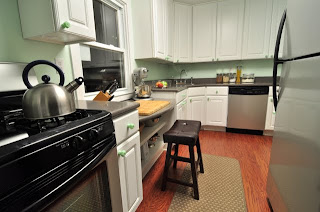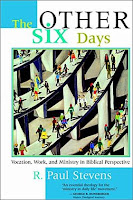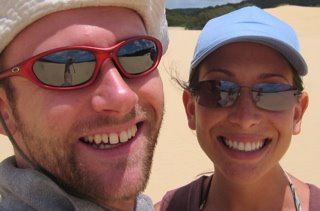As Andrew explained in his
post, we are here in South Bend so that I can study at Notre Dame (for more on ND, see the film
Rudy). Besides being home to one of the world’s most famous college football teams (since only America really competes in this category, it is an easy claim for South Bend to a world title), Notre Dame is famous for being the alma mater of President Bartlett on
The West Wing. But those two descriptors still don’t really communicate what the university is in the minds of Americans.
First, let’s start with pronunciation. Even though many students here speak French, the school name is pronounced
No-ter (or
Notra by the slightly more sophisticated)
Dame (as in, “Gee that dame sure has swell legs). When pronounced with a French accent, Notre Dame signifies the cathedral in Paris.
For Americans, Notre Dame is a top university: not quite Ivy League but considered to be one of the country’s most prestigious schools (remember, Americans use “school for everything from pre-school to grad-school). This perception is partly due to the stunning campus with expansive quads, tree-lined walks, stately brown-brick buildings, the basilica and the golden-domed “main building.” Part of this perception is also due to the famous (although not always high-performing) sports teams. Part of this perception ― and the bit that is most relevant to my study ― comes from the fact ND has really strong academic programs and a really good rate of placing its Ph.D’s in tenure-track positions at other universities.
Now, I guess I need to explain exactly what it is that I’m doing here…
American English Ph.D’s are a bit different from Australian and British Ph.D’s. Most of the students beginning the program already have a masters degree in English or a related field. But, an additional 2-3 years of coursework is still required before students can take their “qualifying exams.” Once a student successfully completes the exams, they can propose a dissertation topic and (with approval) begin writing their dissertation. Most English dissertations are running about 400-500 pages on average and take anywhere from 2-5, or 6, or 7 or 8 years to finish. Some schools (like the University of Chicago and Harvard) are infamous for taking a really long time, with average program running 8 years from start to finish. Notre Dame takes away funding after 5 years, which helps people finish more quickly! (Funding involves a full scholarship for tuition, health coverage, and a salary that is sufficient for 2 people to live on, so it is good to finish before one’s funding runs out.)
Right now, I’m in the “coursework” section of the degree, which means I’m taking classes just like we were at Regent. The difference is, rather than taking one “seminar” and a couple of other less-demanding courses, I take 4 seminar courses and, since everyone is already way too educated, the level of knowledge and thought isn’t like a master’s degree where everyone is just starting out. At the beginning of the term, I was reading about 800 pages a week on average and I’ve written just over 140 pages this semester. Most people (myself included) study for about 60 hours a week (of actual study time, not including meal breaks, chats with other students, etc) but we study more during November and April, since this is when papers are written! What does this mean for day-to-day life? Well, it means I’m really tired most of the time and have little mental energy left for other things (emails, phone calls, taking baths, cooking). It feels like some sort of academic boot-camp where we are being broken down and taught to scramble and just produce more and more writing and read more and more texts until our capacity for such things is expanded beyond any normal human capacity, which seems to be working.
So, am I enjoying all this work?
Yes ― at least most of the time! It is amazing to get to talk about poetry with really brilliant people for hours at a time, especially poets like John Donne or George Herbert or John Keats. I also really enjoy the research involved in writing papers ― sometimes it is really fun just to read what other people think about something and then come up with my own ideas. Other times, I get to try and figure out a historical mystery around a work or writer and that can be really intriguing, as I get to try and place together who knew whom, who read what, and use that to understand the literature better. Sometimes, it is not so fun … especially when taking classes that aren’t in my “field” (which is Victorian and early 20th century novels … but early modern religious poetry is very seductive and could win me over!) but next term I’ll be finished with some of the requirements that are less interesting, so hopefully the study will be more and more enjoyable. Sometimes, it is downright hard ― especially when I have yet another paper to write and I have absolutely nothing to say …
My time at Regent was immensely helpful in preparing me for study here. The work I did on American writer Wendell Berry (his thinking about the concept of “place” and the intersections of his thinking with biblical theologies of creation and land use) not only taught me to manage a large writing project (150 pages) but also gives me a solid background in American agrarian literature (which should be really helpful for one of my courses next term). But, I love stories and especially the ethical implications of narrative and so here I’m planning to work on 19th century novels and perhaps 20th century Catholic revival novels. I won’t go into the details but I’d love to share with you some of my work (if you are interested), so just ask me about it!
Why am I doing this?
Well, that is a good question. The easy answer is that I really love books, love teaching and love research and so I hope to be a college professor or uni lecturer. But the real answer has much more to do with vocation and trying to follow the path that God has opened up … that isn’t to say that God wants me to be a college professor ― or even that he wants me to get a Ph.D, but this is the second time that he’s opened up the opportunity so, it seems like something that I need to do even if the ends are beyond the ends I figure and are altered in the fulfillment…















































